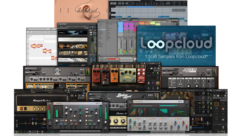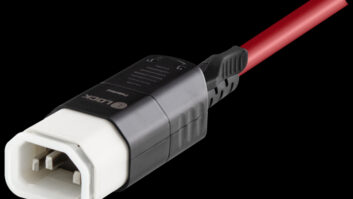
SVC Podcast – Show Notes – Show 176-2
In this edition of the SVC Podcast, Contributing Editor Bennett Liles continues his talk with Nic Dugger of TNDV in Nashville about their fleet of remote TV production trucks and the role of TNDV in the award-winning PBS show Bluegrass Underground. Nic discusses some of the special aspects of producing a television show in a cave including the use of dust covers on equipment and avoiding too quick a return to the surface for optics and other gear that could be damaged by moisture condensation. He also describes the sometimes harrowing job of taking a large TV production truck through the Tennessee mountains. Photo by Michael Weintraub.
TO GO TO PART 1 OF THIS PODCAST
Links of interest:
- Grammy Award-winning Old Crow Medicine Show on Bluegrass Underground
- MultiDyne – Maker of fiber optic production gear used on the show by TNDV Television
- RTS – Intercom system used in TNDV’s remote production trucks
- Sony MVS-8000 video switcher in the Aspiration truck used on the show
- Soundcraft Vi4 mixing console used on the TV show
Download Podcast Here:
https://s3.amazonaws.com/nb-svc/public/public/176-2_TNDV_Nic_Dugger_Blue…
Transcript-
This is the SVC Podcast from Sound & Video Contractor Magazine with Nic Dugger of TNDV Television. Show notes and equipment links for the podcast are on the web site of Sound & Video Contractor Magazine at svconline.com.
Producing the award-winning program Bluegrass Underground is a real challenge because the venue is 300 feet below ground. TNDV Television in Nashville rolls into Tennessee’s Cumberland Caverns for the show. TNDV’s Nic Dugger is back to wrap up his story on how the power, the sound and the video all emerge to be showcased on PBS. Coming right up on the SVC Podcast.
Nic, it’s great to have you back with us for Part 2 on the SVC Podcast from TNDV Television in Nashville with your fleet of remote trucks with some very interesting names. You’ve just finished recording the 7th season of Bluegrass Underground, a national hit music show on PBS. The show is done in a cave, a very nice three million year old cave, but it’s still hundreds of feet below ground in the side of a Tennessee mountain. You go in with cameras and mics and you come out with a hit music show on PBS. What’s the toughest part of doing this one?
Well, it’s good to be back with you for Part 2. I’ve got to say more than anything this show reminds me how important a team is and how important communication amongst that team is. It is Season 7. We’ve been involved for the past six years. And I think the most valuable tool in our playbook is simply the experience of having done it before. An environment like this, trying to do live, multi-camera television is extremely challenging. There’s temperature challenges with the cave itself. There’s the extreme cable runs. And then there’s physically getting the mobile unit back to the mouth of the cave itself, which is one of the most challenging things we face. But having some experience and having done it before and learning from our opportunities in years past has been extremely valuable for us. Fiber technology has made the amount of overall cable to get down in the cave significantly reduced from years past so I’m thrilled that in the world of HD and 4K more fiber optic development continues. And then for us it’s just like any other show. We want to have redundancy in place. We run spare cables. We bring additional lenses. We’re diligent about cleaning and maintaining our equipment in between each show. And something as simple as putting garbage bags or nice canvas camera bags over the cameras every night to keep the dust off as it settles when the crowd leaves makes a big difference and can guarantee that we’ll be able to do this show for many years to come. [Timestamp: 2:35]
Yeah. Since there’s no wind blowing through that place if you kicked up some dust it would settle on mics, cameras and everything. They call it the Volcano Room and it looks fantastic but how are the acoustics in that big cave? I would think that if they’re difficult, there’s not a whole lot you could do.
Well, I think the acoustics are one of the things that makes this venue extremely unique because you would assume in a cave you might have echo problems. There’s images of cartoon characters shouting into dark caves and getting echoes back. But the Volcano Room is actually a very sound-appropriate room. It feels like you’re in a control room space when you’re down there. So when it comes to PA for the crowd we don’t need much. We’re not flying line arrays for the 700 attendees. We have very small speakers on stands because the room itself is so well acoustically insulated that it doesn’t need much. And I think that’s been noticed for many years and why this project came to fruition like it did, because when you walk through the room, even on just a simple cave tour, you notice immediately that the acoustics are very desirable in the space. And I think that’s probably why music performances started happening down in here. The space just leant itself to that kind of work. [Timestamp: 3:44]
I believe Tennessee has more caves than any other state and this one is not too far from home for TNDV, but getting one of your big remote trucks up the mountain and parked within cable distance of this subterranean performing area has got to be somewhat difficult to say the least.
You know, it certainly can be. We do a lot of work in Atlanta and for us that means crossing over Monteagle Mountain in I24 on an almost weekly basis. And one of the tricky things about a mountain is not necessarily getting up, but it’s getting down safely. And I’m always a little leery as I go down Monteagle Mountain of the truck ramps for runaway trucks that have been installed simply for when a truck loses control they have a safe place to crash into the rocks. Luckily we’ve never had to use one of the runaway truck ramps, but every time I drive past them I run the numbers in my head of what it would take to get a truck pulled out of that, cleaned up and back on the road. [Timestamp: 4:35]
Well, let’s hope you don’t have to find out. I don’t even like to think about it.
Me either! (Laughs)
(Laugh) This is a music show so is it still pretty much the standard thing with the stage monitoring and front of house set up separately inside the cave?
Yeah, for audio. You know, of course being in Music City, Tennessee, there’s no shortage of very strong audio crew and audio hardware. So we do it the right way. There’s a three-way split involved. Front of house has a split, the monitor engineer has their own split, and then we take a third split to the truck. And what that allows us to do is a true front of house mix for the guests in the cave. Monitors can mix wedges and ears for the artists so they can hear what they need to hear. And then out in the truck we take a full split plus add all of our crowd microphones on top of that to where we can do a true broadcast mix that’s not mixed in that space. Again, we’re hundreds if not thousands of feet away from where the music is in one of our acoustically-treated sound booths. And that A1 in the truck can get a solid broadcast mix that’s ready for television. And then of course in addition we roll Pro Tools and a backup multitrack recorder so post-audio mixing can take place even after the fact if there’s any cleanup work they want to do. [Timestamp: 5:43]
And certainly no noise complaints from the neighbors.
Ah, no. Luckily for us the nearest neighbor is a few miles away so we can get as loud and rowdy as we want.
And looking at the videos from the show, that’s exactly what they do. They certainly have a big time down there. I saw some water running down the walls in some of the pictures. Is that happening in the Volcano Room or is that among the things you see on the way down there?
There are certainly tide pools on the way down. Of course this is a real cave. This is not a man-made structure. It is a working, living cave and that means there is runoff from rain, there’s drops and drops from the ground above, there’s pools along the path that have collected over the thousands of years this cave has been in place. What’s really cool is the owners of the cave and the managers of the show really want to give the attendees the unique experience so they light the path not just with light to see, but they’ll uplight features of the cave. They’ll downlight some of the pools of water so that as you’re taking your 30-minute hike from the mouth of the cave down into the Volcano Room, you truly get an experience of spelunking for the day as you work your way down to watch this concert. And it’s a really cool experience. I hate to sound cliché and call it magical, but it’s a pretty magical experience to take that walk from where the truck is parked outside the cave down into the Volcano Room and experience what this facility has to offer. [Timestamp: 7:03]
Well, the sound and lighting are great and the talent they get in there is fantastic. I was wondering though, does all of that perpetually dripping water ever come through on the mics?
You know, it doesn’t. The Volcano Room is one of the more dry spaces in the cave. There’s none of that standing water or running water I mentioned. But when you get artists in there, you know, like this year we’re excited that Blues Traveler is going to be there with us. The Mavericks are coming this year. When these guys get jamming they’re so loud and fun that you’d have a hard time hearing a drip in a cave like that. So luckily it’s not a problem. [Timestamp: 7:32]
Now, there has to be some serious backup power in there because if you ever lost the lights you couldn’t see your hand in front of your face.
(Laughs) You’re absolutely right. Because this is such a popular tourist attraction the city of McMinnville has actually run power all the way down into the cave and that includes exit sign-style safety lights that have a battery backup. So should we need to evacuate the cave, even without power, folks would be able to see to get their way out. That residential power is not enough for our production so we do park a twin pack of generators at the mouth of the cave and run a thousand feet of feeder cable for our lighting power. So while we don’t have a true redundant power system there are backups in place to make sure everyone can see to get back out should they need to evacuate for any reason. [Timestamp: 8:17]
You’ve got the generators parked near the truck and you sure don’t have to worry about hearing those all the way down in that cave.
(Laughs) No. There’s a good thousand feet or more. Yeah, absolutely.
So how long does it take to record one of these shows? Your crew is in there for several days?
We are. Once we get loaded in – and load-in takes a little over a day and a half before we start getting into serious sound checks, we’ll line up a number of artists, typically four to five artists per night for three nights. And the goal is the get one show out of each individual artist. So it’s realistic that we’ll get 12 to 15 separate episodes in a single weekend of shooting, and it would take between an hour and a half to two hours per artist to capture their set including their sound checks. [Timestamp: 9:00]
Okay. And what do you use in the truck to get this show done for TV? The video switcher, sound mixer and all that.
Sure. In Aspiration there’s a Sony MVS-8000 switcher. Audio-wise we’re mixing on a Studer audio console. I mentioned Pro Tools is how we record the multitrack, and we use a Sound Devices PIX 270 recorder as a backup multitrack recorder. For video we like Key Pro. We have Key Pro racks that record all the iso-record and the live line cut. And then for monitoring we have Boland, Sony and some TVLogic monitors throughout the truck. Higher-end monitors like our Sony 17-inch OLED’s for the video shader and the lighting director. And then we have some 65-inch Boland OLED monitors on the monitor wall. And then finally we have a series of 25-inch Panasonic color-grading monitors for the director and technical director to use. [Timestamp: 9:50]
And a lot of people have to communicate. What is that? An RTS intercom?
It is. We have an RTS ADAM Matrix on board so everybody in the truck has a KP-style key panel and then we run belt packs running additional users down in the cave itself. We actually even do a matrix panel for our lighting director in the cave. And then all the cameras receive their intercom down there SMPTE fiber cable. [Timestamp: 10:12]
That sounds like as big a show going on behind the scenes as it is for the viewers and I know your people get a real workout putting all of this together. So what else does TNDV Television have coming up after this?
We’re extremely busy. Most weekends in March we’re five or six shows deep concurrently. In addition to Bluegrass Underground this week we’re helping produce the Stellar Awards of gospel music in Las Vegas. We’ll have trucks onsite in Lexington, Kentucky at Horse Park for a large equestrian event, Road to the Horse. We’re doing fencing for TSSAA. We also have our audio truck, Vibration, that’s working with North Point Church down in Georgia this weekend. And then next weekend is the Final Four. We’ll help Turner produce all of the concerts outside of the Final Four tournament in Phoenix this year. We’re also going to be in Washington, D.C. for the Horatio Alger Awards, and then we have a benefit event here in Nashville, Dancing for Safe Haven, one of our charitable organizations we work with. So we have a very busy few weeks ahead. [Timestamp: 11:13]
Sounds like I should have asked what you’re NOT doing then.
(Laughs) We’ve got to stay busy. We sure love what we do.
I know it’s hard work, but as long as those trucks are on the road they’re paying for their keep and I’m glad you have them all well-booked. Thanks for the details on this one. It’s Nic Dugger from TNDV Television in Nashville and the big music show Bluegrass Underground on PBS. Thanks for getting with us.
My pleasure. Everyone have a great day.
Thanks to Nic Dugger and TNDV Television and thank you for being here with us on the SVC Podcast. Show notes and equipment links for this podcast are on the website of Sound & Video Contractor Magazine at svconline.com. We’ll be back again next week with the SVC Podcast.










